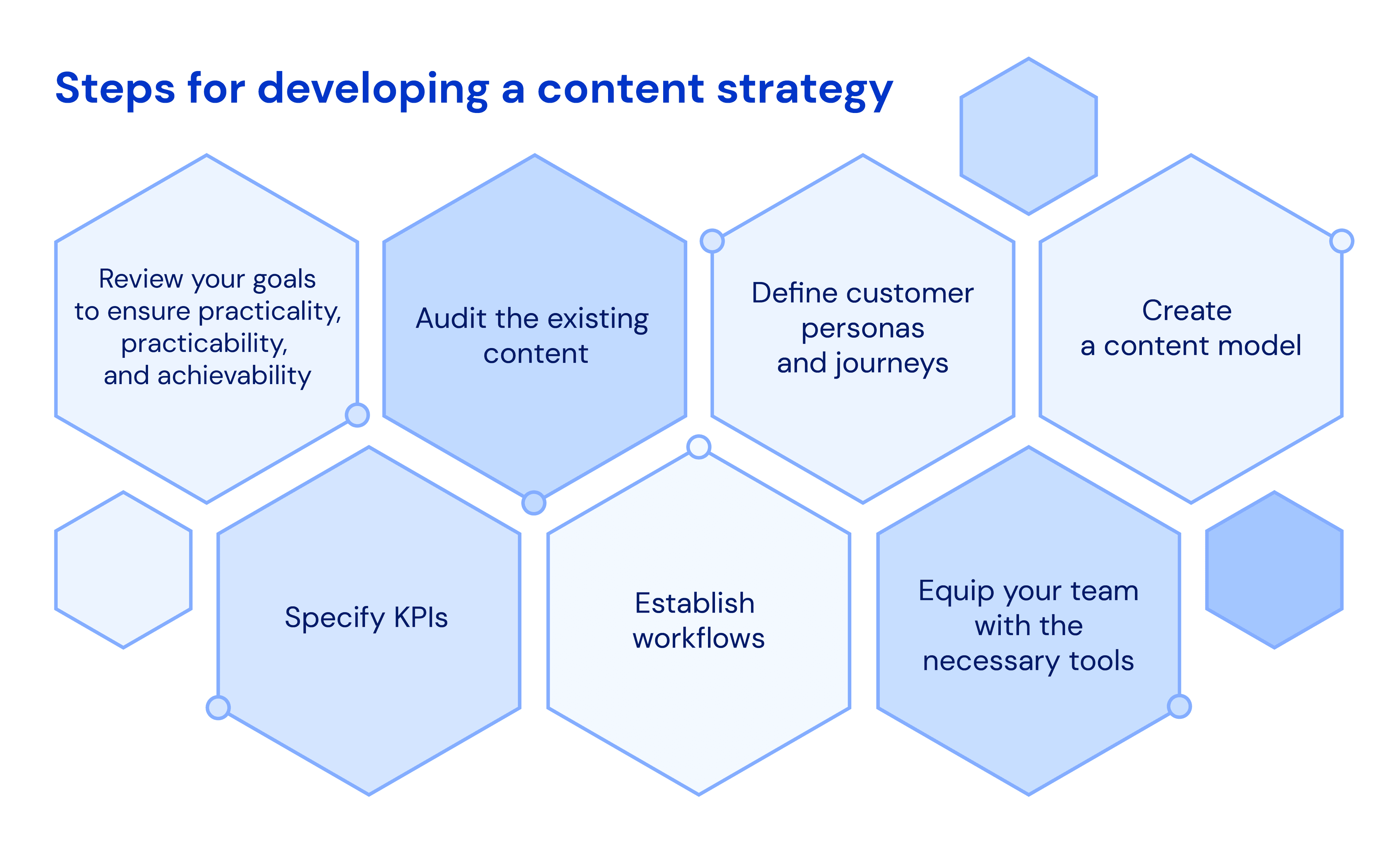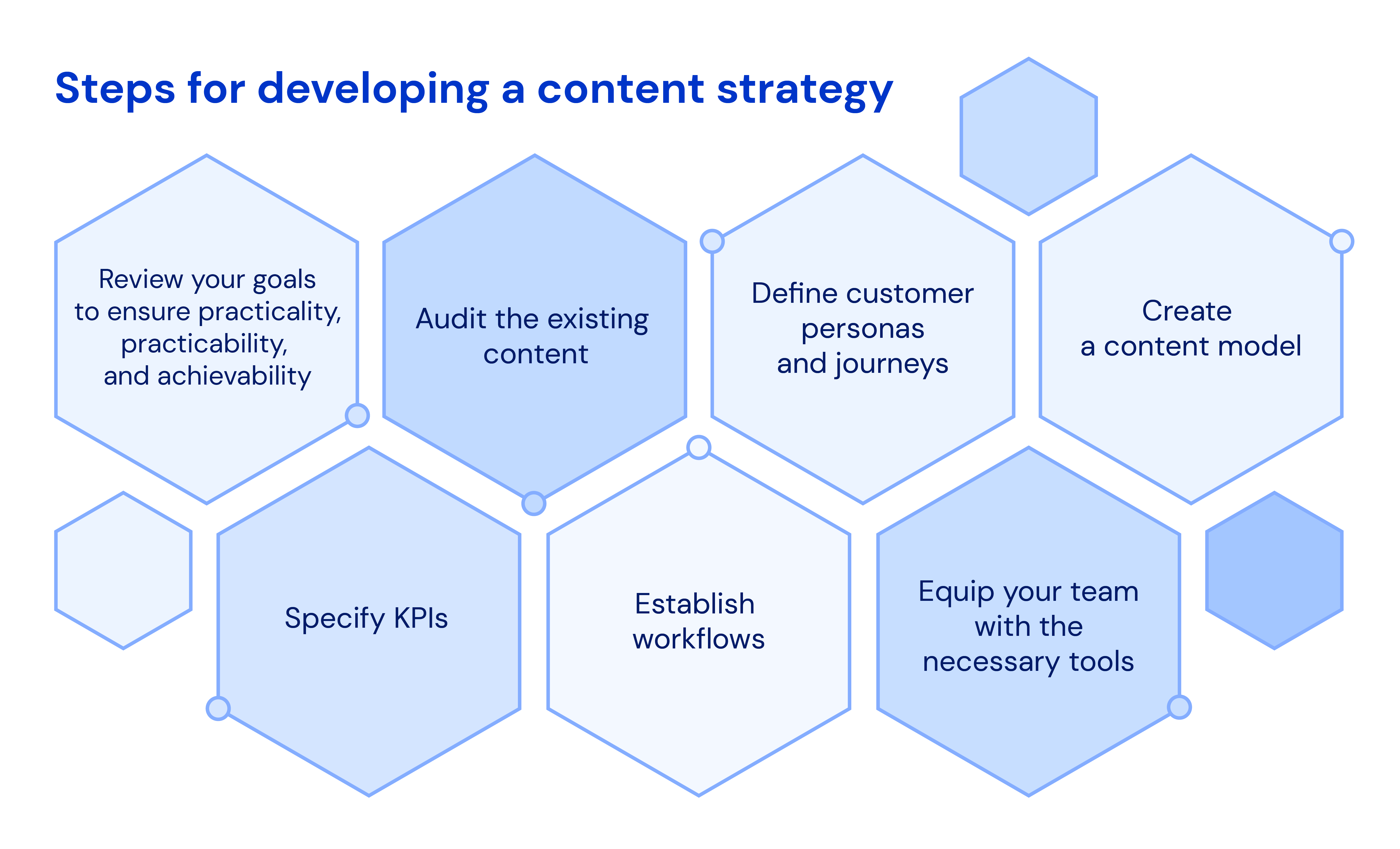Uniform blog/Creating an effective content strategy
Creating an effective content strategy
Creating an effective content strategy
Nowadays, brands bent on success must create content that resonates. However, given the plethora of platforms, algorithms, and competition, building and launching a content strategy can be overwhelmingly labor intensive and time consuming.
To save you time and effort, this in-depth guide on effective content strategies describes the basics, e.g., what defines a content strategy and how to create one; as well as advanced topics like an explanation of structured content and the procedure on how to make evergreen content. All told, you’ll learn what productive content-creation tools you need for confidently building enticing web experiences that will keep your brand at the forefront of your audience’s mind.
What is a content strategy?
A content strategy, which is a game plan or roadmap that guides a content team’s production efforts, typically contains the following:
- Your content-marketing goals.
- The stories or messaging through which to achieve the goals.
- The platforms of your choice.
At the outset, perform a “step zero,” i.e., the most critical step, by populating your content strategy with as much detail as possible. Next, since content is the direct link to your target audience, you must secure buy-in and support from all stakeholders for the strategy.
The best way to win that endorsement is to evangelize, educate, and inform. So, present your strategy along with back-up logic and data, and you’ll have a smooth sail winning approval.
How to create a content strategy?
The process takes seven steps.

Step 1: Review your goals to ensure practicality, practicability, and achievability.
An efficacious content strategy must align with your business goals. Therefore, content teams must examine their true identity, define their target audience, decide which platforms to adopt, and devise a plan for gaining leads and customers.
Even though all that information might already be available in your branding guidelines, do conduct a thorough review before starting the creation process. A second look with a fresh perspective helps you identify areas for improvement and ascertain that your content stays on-brand.
Additionally, examine the content-marketing campaigns of your top competitors and then fill in their messaging gaps. Such a step also leads to deeper relationships with your target customers.
Take a service organization, such as a doctor’s or lawyer’s practice, that’s looking for leads. Connecting with client prospects would require a different content strategy than that of a blog that aims at growing its subscription base and attracting repeat traffic.
Step 2: Audit the existing content.
This step would be more efficient and would produce more informed results if a content model is in place as reference. Otherwise, this is the perfect time to create that model.
An audit of your existing content helps determine if the material is consistent, balanced, and purposeful. Your content model lends an easy way to do so and to ensure that your strategy shoots for the same common goal. Besides, you might spot opportunities to reuse and recycle content that escaped your notice before.
To perform a proper audit, look at a sample of your current content and some of your competitors’. Find out what’s working well, what’s not, what you’re presenting, and what are the messages those content pieces convey. Ultimately, you’ll learn what’s out there in the wild, identify what might be missing, and develop a plan for filling those gaps and spiffing up your site.
This is where evergreen content comes into play. What is evergreen content? That’s content written in a way that makes it withstand the test of time, usually with no references to specific dates or time frames. As a result, the material would resonate with your audience no matter when they view it.
A few examples of evergreen content:
- Articles on history
- FAQs
- Testimonials
- Industry-specific resources
- Indexes or glossaries
- Tutorials
As is obvious, because it’s reusable and recyclable, evergreen-content strategy translates to huge time savings for audits and updates. When coupled with a productive content model, evergreen content can boost campaign scalability and ROI.
Step 3: Define customer personas and journeys.
Customer personas are the basis for a granular understanding of your ideal audience, and a vivid picture of your target customer preludes content resonance.
Create customer personas with the following data:
- Detailed demographic and psychographic information. What job does your target audience hold? What’s their income level? What’s the typical neighborhood in which they live? What are their hobbies and interests?
- Your target audience’s fears and desires. What will emerge are the factors that motivate those people to do business with the brands of their choice. You can then show them your solution and its benefits.
The customer journey is the path visitors take while interacting with your brand—from the platform and message that pointed them your way to their decision to do business with you.
Answer the questions below for this step:
- What signs or triggers identify a particular stage?
- What’s likely to give potential customers that “final push” toward a purchase decision?
- Where in the journey should you focus your strategy?
- At what point should your sales team become involved?
Step 4: Create a content model.
As a visual representation of your live and to-be-published content, a content modelis an essential tool for your strategy.
The model breaks down your structured content into types (blogs, YouTube videos, course modules) and content attributes (meta descriptions, author bios, titles), which make up those types. With such a visual inventory of your content “puzzle” and its components, content teams can pinpoint opportunities for reuse, recycling, and simplification. Doing so results in a single source of truth for your content, plus consistency, scalability, faster content delivery, and a higher campaign ROI.
Step 5: Specify KPIs.
Clear-cut Key Performance Indicators (KPIs) are paramount goals or targets for measuring the success of any marketing effort, especially content marketing.
Perform these two steps:
- Find out the vital metrics that determine campaign success. To generate sales, for example, you would look at the number of potential leads and conversions, the conversion rate, the average value per customer, etc.
- Dig deeper into those numbers by answering these questions:
- What does each number reveal about your campaign’s performance?
- Should you compare those numbers to an industry standard or your internal historical data? Note: The best KPIs are tied to outcomes, not the amount of content.
Afterwards, it’ll be a breeze to assess and recalibrate content campaigns for success and a higher ROI of your strategy.
Here are three KPI examples:
- Brand mentions: A high volume of brand mentions might reflect that your content-marketing efforts are bolstering recognition and visibility of your brand.
- Conversion rate: A high conversion rate might mean that your content is effectively interacting with your audience and convincing them to make a purchase, fill out a form, subscribe to a newsletter, etc.
- Social-media engagement: A high level of social-media engagement might result in more brand awareness, traffic, and conversions.
Step 6: Establish workflows.
All stakeholders who participate in producing content must be on the same page, but where do they fit within that process? For the answer, the team that’s working on your content strategy must have a clear picture of the stakeholders’ roles and responsibilities.
A sound tip is to have all team members focus on their “number” that ties directly into your content strategy and KPIs. Say, your graphics team must produce 10 quality infographics per week. Obviously, those infographics must hit certain standards, but the team members know that they’re responsible for that weekly goal, i.e., a target that propels progress toward the goal.
Next, establish workflows to “connect the dots.” Describe how content moves from department to department and from deliverable to deliverable.
Not least, to ensure absolute transparency of roles and targets, document the details as a handy reference for team members.
Step 7: Equip your team with the necessary tools.
Leveraging the right tools can make all the difference in the effectiveness of a content strategy. Following are a few examples of the critical ones:
- Web analytics
- Content publishing and scheduling
- Social-media platforms
- Audience insights
- SEO
- Email marketing
- Marketing automation
Avoid having so many tools that they hinder production workflows. A comprehensive tool like Uniform would be an excellent choice, thanks to its features that simultaneously facilitate multiple functions to streamline content production.
For details on the benefits of Uniform, schedule a free demo. You’ll find out how going beyond a traditional content-management system and embracing a digital experience composition platform (DXCP) transforms content modeling and orchestration for outstanding results.
A successful content strategy attracts your target audience throughout their journey of your site by establishing deep relationships with them that continue even after the sale.







.jpg&w=1080&q=90)
.jpg&w=1080&q=90)